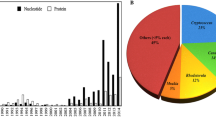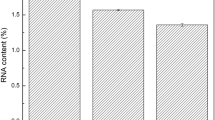Abstract
We have previously reported that the cultivation of yeast cells with soy peptides can improve the tolerance of yeast to freeze–thaw stress (Izawa et al. Appl Microbiol Biotechnol 75:533–538, 2007), indicating that soy peptides can modify the characteristics of yeast cells. To gain a greater understanding of the potencies of soy peptides, we further investigated the effects of cultivation with soy peptides on yeast physiology and found that soy peptides repress the formation of lipid bodies (also called lipid droplets or lipid particles), in which neutral lipids are accumulated. Compared with casein peptone, bacto peptone, yeast nitrogen base, and free amino acid mixtures having the same amino acid composition as soy peptides, cultivation with soy peptides caused decreased levels of mRNAs of neutral lipid synthesis-related genes, such as DGA1, and repressed the formation of lipid bodies and accumulation of triacylglycerol. These results indicate that soy peptides affect the lipid metabolism in yeast cells, and also demonstrate a potentiality of edible natural ingredients as modifiers of the characteristics of food microorganisms.






Similar content being viewed by others
References
Amberg DC, Burke DJ, Strathern JN (2005) Methods in yeast genetics: A Cold Spring Harbor Laboratory course manual, 2005th edn. CSHL, New York
Athenstaedt K, Zweytick D, Jandrositz A, Kohlwein SD, Daum G (1999) Identification and characterization of major lipid particle proteins of the yeast Saccharomyces cerevisiae. J Bacteriol 181:6441–6448
Beller M, Thiel K, Thul PJ, Jäckle H (2010) Lipid droplets: a dynamic organelle moves into focus. FEBS Lett 584:2176–2182
Czabany T, Wagner A, Zweytick D, Lohner K, Erich L, Ingolic I, Daum G (2008) Structural and biochemical properties of lipid particles from the yeast Saccharomyces cerevisiae. J Biol Chem 283:17065–17074
Digel M, Ehehalt R, Füllekurg J (2010) Lipid droplets lighting up: insights from live microscopy. FEBS Lett 584:2168–2175
Folch J, Lees M, Sloane-Stanly GH (1957) A simple method for the isolation and purification of total lipids from animal tissues. J Biol Chem 226:497–509
Greenspan P, Mayer EP, Fowler SD (1985) Nile Red: a selective fluorescent stain for intracellular lipid droplets. J Cell Biol 100:965–973
Hori G, Wang MF, Chan YC, Komatsu T, Wong Y, Chen TH, Yamamoto K, Nagaoka S, Yamamoto S (2001) Soy protein hydrolyzate with bound phospholipids reduces serum cholesterol levels in hypercholesterolemic adult male volunteers. Biosci Biotechnol Biochem 65:72–78
Izawa S, Ikeda K, Takahashi N, Inoue Y (2007) Improvement of tolerance to freeze-thaw stress of baker's yeast by cultivation with soy peptides. Appl Microbiol Biotechnol 75:533–538
Kahana JA, Schlenstedt G, Evanchuk DM, Geiser JR, Hoyt MA, Silver PA (1999) The yeast dynactin complex is involved in portioning the mitotic spindle between mother and daughter cells during anaphase B. Mol Biol Cell 9:1741–1756
Kamisaka Y, Noda N, Sakai T, Kawasaki K (1999) Lipid bodies and lipid body formation in an oleaginous fungus. Mortierella ramanniana var. angulispora. Biochim Biophys Acta 1438:185–198
Kamisaka Y, Kimura K, Uemura H, Shibakami M (2010) Activation of diacylglycerol acyltransferase expressed in Saccharomyces cerevisiae: overexpression of Dga1p lacking the N-terminal region in the Δsnf2 disruptant produces a significant increase in its enzyme activity. Appl Microbiol Biotechnol 88:105–115
Kitamoto K, Oda K, Gomi K, Takahashi K (1990) Construction of uracil and tryptophan auxotrophic mutants from sake yeast by disruption of URA3 and TRP1 genes. Agric Biol Chem 54:2979–2987
Kitagawa S, Mukai N, Furukawa Y, Adachi K, Mizuno A, Iefuji H (2008) Effect of soy peptide on the beer brewing. J Biosci Bioeng 105:360–366
Leber R, Zinser E, Zellnig G, Paltauf F, Daum G (1994) Characterization of lipid particles of the yeast, Saccharomyces cerevisiae. Yeast 10:1421–1428
Martinez-Villaluenga C, Bringe NA, Berhow MA, Gonzalez de Mejia E (2008) β-conglycinin embeds active peptides that inhibit lipid accumulation in 3 T3-L1 adipocytes in vitro. J Agric Food Chem 56:10533–10543
Martinez-Villaluenga C, Rupasinghe SG, Schuller MA, Gonzalez de Mejia E (2010) Peptides from purified soybean β-conglycinin inhibit fatty acid synthase by interaction with thioesterase catalytic domain. FEBS J 277:1481–1493
Mochizuki Y, Maebuchi M, Kohno M, Hirotsuka M, Wadahama H, Moriyama T, Kawada T, Urade R (2009) Changes in lipid metabolism by soy β - conglycinin-derived peptides in HepG2 cells. J Agric Food Chem 57:1473–1480
Murphy DJ (2001) The biogenesis and functions of lipid bodies in animals, plants and microorganisms. Prog Lipid Res 40:325–438
Nishiura H, Imai H, Nakao H, Tsukino H, Kuroda Y, Katoh T (2002) Genetically modified food (food derived from biotechnology):current and future trends in public acceptance and safety assessment. Nippon Koshu Eisei Zasshi 49:1135–1141
Oelkers P, Cromley D, Padamsee M, Billheimer JT, Sturley SL (2002) The DGA1 gene determines a second triglyceride synthetic pathway in yeast. J Biol Chem 277:8877–8881
Ogasawara M, Tsuruta K, Arao S (2002) Flame photometric detector for thin-layer chromatography. J Chromatogr A 973:151–158
Sandanger L, Gustavsson MH, Ståhl U, Dahlqvist A, Wiberg E, Banas A, Lenman M, Ronne H, Stymne S (2002) Storage lipid synthesis is non-essential in yeast. J Biol Chem 277:6478–6482
Schmitt ME, Brown TA, Trumpower BL (1990) A rapid and simple method for preparation of RNA from Saccharomyces cerevisiae. Nucleic Acids Res 18:3091–3092
Sorger D, Daum G (2002) Synthesis of triacylglycerols by the acyl-coenzyme A: diacyl-glycerol acyltransferase Dga1p in lipid particles of the yeast Saccharomyces cerevisiae. J Bacteriol 184:519–524
Sturley SL, Young TW (1988) Extracellular protease activity in a strain of Saccharomyces cerevisiae. J Inst Brew 94:23–27
Takenaka A, Annaka H, Kimura Y, Aoki H, Igarashi K (2003) Reduction of paraquat-induced oxidative stress in rats by dietary soy peptide. Biosci Biotechnol Biochem 67:278–283
Tsuruki T, Takahata K, Yoshikawa M (2004) A soy-derived immunostimulating peptide inhibits etoposide-induced alopecia in neonatal rats. J Invest Dermatol 122:848–850
Uzogara SG (2000) The impact of genetic modification of human foods in the 21st century: a review. Biotechnol Adv 18:179–206
Valachovic M, Hronská L, Hapala I (2001) Anaerobiosis induces complex changes in sterol esterification pattern in the yeast Saccharomyces cerevisiae. FEMS Microb Lett 97:41–45
Acknowledgements
This study was supported by a grant from the Fuji Foundation for Protein Research and the Iijima Memorial Foundation for the Promotion of Food Science and Technology.
Author information
Authors and Affiliations
Corresponding author
Rights and permissions
About this article
Cite this article
Ikeda, K., Kitagawa, S., Tada, T. et al. Modification of yeast characteristics by soy peptides: cultivation with soy peptides represses the formation of lipid bodies. Appl Microbiol Biotechnol 89, 1971–1977 (2011). https://doi.org/10.1007/s00253-010-3001-9
Received:
Revised:
Accepted:
Published:
Issue Date:
DOI: https://doi.org/10.1007/s00253-010-3001-9




